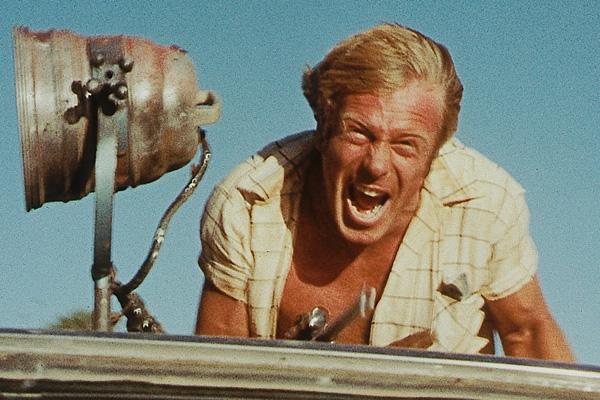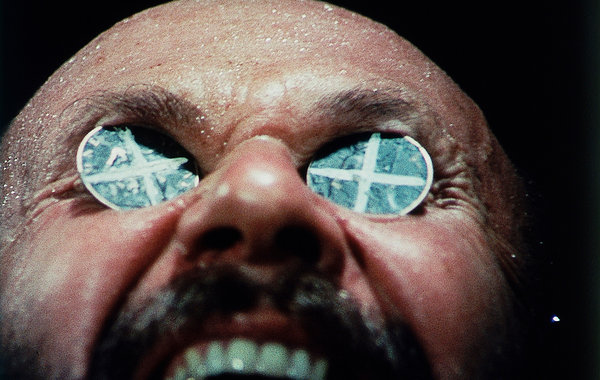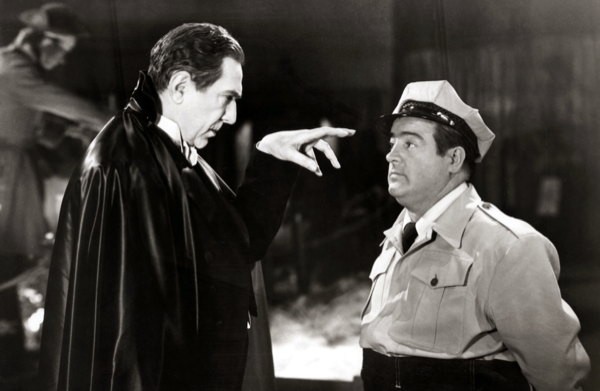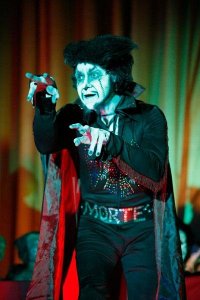 WAKE IN FRIGHT (1971); Dir: Ted Kotcheff; Starring Gary Bond, Donald Pleasence and Chips Rafferty; Through Dec. 13 at Landmark Midtown Art Cinema; Dec. 14-20 at The Plaza Theatre. Trailer here; Tickets here (visit website for prices and showtimes).
WAKE IN FRIGHT (1971); Dir: Ted Kotcheff; Starring Gary Bond, Donald Pleasence and Chips Rafferty; Through Dec. 13 at Landmark Midtown Art Cinema; Dec. 14-20 at The Plaza Theatre. Trailer here; Tickets here (visit website for prices and showtimes).
By Aleck Bennett
Contributing Writer
“Have a drink, mate? Have a fight, mate? Have some dust and sweat, mate? There’s nothing else out here.”
– WAKE IN FRIGHT poster tagline
The 1970s and 1980s were ground zero for a renaissance in Australian filmmaking. Beginning December 7, Landmark Midtown Art Cinema offers a rare chance for you to witness one of the groundbreaking films that sparked that boom: Ted Kotcheff’s 1971 film WAKE IN FRIGHT.
In the late 1960s, the film industry in Australia was basically nonexistent. To remedy this, John Gorton (Australia’s Prime Minster from 1968-1971) set into motion several policies and governmental agencies to promote local filmmaking. Sensing a need for native Australian film, local production companies began collaborating with outside studios in the first few years of Gorton’s administration, the most notable results being Michael Powell’s AGE OF CONSENT (1969), Tony Richardson’s NED KELLY (1970), Nicolas Roeg’s WALKABOUT (1971) and Ted Kotcheff’s WAKE IN FRIGHT.
Both Powell’s and Richardson’s films were critical and commercial failures, and as a result, didn’t contribute much to the notion of Australia as a hotbed of cinematic activity. Roeg’s WALKABOUT, on the other hand, was a critical and commercial triumph, yet its authenticity as a truly representative Australian film was in dispute immediately upon release. It was based on a novel by British author James Vance Marshall, featured a screenplay written by British playwright Edward Bond, was directed by British director Nic Roeg, starred his son alongside British actress Jenny Agutter, was produced by American businessmen Max Raab and Si Litvinoff (whose production company was incorporated in Australia), financed with funds raised in America and distributed by US-based company 20th Century Fox.
WAKE IN FRIGHT, however, sported a much more authentic Aussie pedigree. Whereas WALKABOUT used the Australian outback as primarily a vehicle for Roeg’s surreal vision, WAKE IN FRIGHT engaged the oppressive landscape as almost a character in itself. Based on the 1961 novel by Australian journalist Kenneth Cook and based on his own experiences, the screenplay by British writer Evan Jones—who consulted with Cook on its creation—hewed as closely to the original text as possible. The story finds a young schoolteacher from the city, John Grant (Gary Bond), posted to a tiny school in the outback town of Tiboonda. As the Christmas holiday begins, he plans to take a flight to Sydney to visit his girlfriend, but finds himself waylaid at a train station in the nearby mining town of Bundanyabba (aka “the Yabba”) as he waits to make the flight. After getting sucked into the hard-drinking ways of the townspeople, he loses his money gambling, loses his chance to make his plane…and slowly begins to lose his mind.

Jack Thompson in WAKE IN FRIGHT (1971), Drafthouse Films.
The screenplay was initially to be filmed in 1963 by Joseph Losey, with whom Jones had collaborated on the ’63 Hammer film THE DAMNED. A lack of financial backing doomed the project, and the screenplay was kicked around for nearly a decade. In 1968, Jones collaborated with Canadian director Ted Kotcheff (FIRST BLOOD, UNCOMMON VALOR, NORTH DALLAS FORTY) and felt that the director would be a good match for the screenplay. Kotcheff fell in love with the script, and immediately set about the business of raising funds and casting the film.
Kotcheff arrived with his family in Australia in 1969, determined to soak up Aussie culture in order to more realistically depict the people and locations described in the novel and screenplay. With his assistant director Howard Rubie, Kotcheff explored the worlds of illegal casinos, kangaroo hunters, Returned Services League veterans’ clubs, and the blue-collar pubs of dock workers and the like. As Kotcheff related to Australia’s National Film & Sound Archive, the pair sought out the kind of places “whose clientele clock off work at 6 a.m. and are heavily into the drinking by 9 a.m.—we did a lot of drinking.”
In many cases, it takes an outsider’s eye to catch details or present a perspective that might be glossed over by one more familiar with a place or subject. In this instance, Ted Kotcheff perfectly captures the bleakness of life in the outback before the internet, decent roads and efficient train and plane travel increased connectivity. In this much larger world, everything and everyone bakes in the 100-degree weather, and dust coats every surface. Likewise, an attitude of aggressive friendliness also coats the culture of drinking, gambling and game hunting that pervades the community. And in the Yabba, the mateship and seemingly out-of-place Christmas decorations also mask the sinister and menacing eye cast upon the outsider in its midst.

Donald Pleasance in WAKE IN FRIGHT (1971) Drafthouse Films.
The film opened in Sydney to worldwide acclaim. Ted Kotcheff was nominated for the Palm D’Or award at the Cannes Film Festival, and the film was tremendously commercially successful in France and Great Britain. However, it failed to find an audience in Australia. Said co-star Jack Thompson in the 2008 documentary NOT QUITE HOLLYWOOD: THE WILD, UNTOLD STORY OF OZPLOITATION!, “Australians at the time didn’t want to see it (the film) as Australia. People would walk away saying ‘That’s not us. We don’t behave like that.’” Kotcheff counters, “As a foreigner, you see things that Australians take for granted or accept as part of the dailiness of their life. They don’t see what’s eccentric or idiosyncratic about their life.”
However, the critical and (at least overseas) commercial success of WAKE IN FRIGHT and WALKABOUT lent credence to the notion that Australia was indeed a place to be taken seriously as a cinematic force. Jack Thompson confirms this, saying “What they provided was the knowledge for would-be Australian filmmakers that we had the ability to tell tales about ourselves in a way that was dynamic and interesting.”
In the wake of these early films came what would be known as the Australian New Wave of cinema, producing such soon-to-be-internationally-known talents as directors Peter Weir, Bruce Beresford, John Duigan and Fred Schepisi. The exploitative elements of WAKE IN FRIGHT (released stateside as OUTBACK) also proved to be influential in the development of what would later be known as “Ozsploitation.” Filmmakers such as George Miller, Russell Mulcahy and Richard Franklin seized upon the needs of the action and horror marketplace that was opened up by WAKE IN FRIGHT with films like MAD MAX, MAD MAX 2: THE ROAD WARRIOR, RAZORBACK and ROAD GAMES. Echoes of WAKE IN FRIGHT’s depiction of building dread can be found in films as recent as Aussie Greg Mclean’s 2005 film WOLF CREEK.
For years, the film WAKE IN FRIGHT was thought to be essentially lost. While it was released on VHS in the US, prints of the film were nearly impossible to find. 16mm prints of the movie were found, but were in poor condition for screening. The only full 35mm print of the movie, which was found in Dublin, was deemed to be of insufficient quality for commercial release. The film’s editor, Anthony Buckley, began searching for the film’s original elements in 1996. After years and years of false leads, prolonged negotiations with foreign rights holders and digging through cut and mangled prints of the movie, Buckley found the original film negatives in a shipping container marked “For Destruction.” Were it not for his efforts, the film would be nearly impossible to see today. Australia’s National Film & Sound Archive completed a full digital restoration in 2009, and premiered the new print at the Sydney Film Festival that year. It was later selected by Martin Scorsese as a Cannes Classic and was screened at that year’s Cannes Film Festival—with Michelangelo Antonioni’s L’AVVENTURA, it is one of only two films to ever be screened twice at Cannes.
Brutal in its honesty, bleak in its vision and startlingly original in its approach, WAKE IN FRIGHT is a long-hidden masterpiece of cinema, ranking with the best of the Australian New Wave and transcending even that pigeonholing. It’s where the Australian filmmaking renaissance started, and set a nearly impossible standard for all that followed.
Aleck Bennett is a writer, blogger, pug warden, pop culture enthusiast, raconteur and bon vivant from the greater Atlanta area. Visit his blog at doctorsardonicus.wordpress.com
 Splatter Cinema present CHILD’S PLAY (1987); Dir: Tom Holland; Starring: Brad Dourif, Chris Sarandon and Catherine Hicks; Tue. Jan. 8 @ 9:30 p.m. and Fri. Jan. 10 at 11:30 p.m.; Plaza Theatre; Trailer here.
Splatter Cinema present CHILD’S PLAY (1987); Dir: Tom Holland; Starring: Brad Dourif, Chris Sarandon and Catherine Hicks; Tue. Jan. 8 @ 9:30 p.m. and Fri. Jan. 10 at 11:30 p.m.; Plaza Theatre; Trailer here. The film was helmed by veteran horror writer-director Tom Holland (CLASS OF 1984, PSYCHO II, FRIGHT NIGHT) with a seriousness that served as a perfect counterweight to the cartoonish possibilities that an ersatz Cabbage Patch Kid slaughtering Chicagoans might pose. And his cast of familiar faces (and voices) helped sell that premise. In particular, the sardonic performance of Brad Dourif as Chucky walked the tightrope between threatening and humorous deftly, simultaneously communicating Chucky’s thirst for violence and his recognition that being stuck in a doll’s body is almost some kind of cosmic joke at his expense.
The film was helmed by veteran horror writer-director Tom Holland (CLASS OF 1984, PSYCHO II, FRIGHT NIGHT) with a seriousness that served as a perfect counterweight to the cartoonish possibilities that an ersatz Cabbage Patch Kid slaughtering Chicagoans might pose. And his cast of familiar faces (and voices) helped sell that premise. In particular, the sardonic performance of Brad Dourif as Chucky walked the tightrope between threatening and humorous deftly, simultaneously communicating Chucky’s thirst for violence and his recognition that being stuck in a doll’s body is almost some kind of cosmic joke at his expense.









